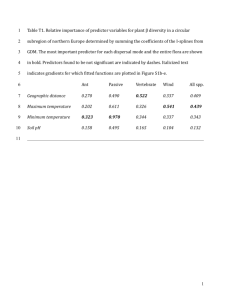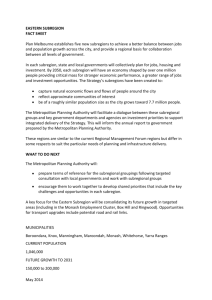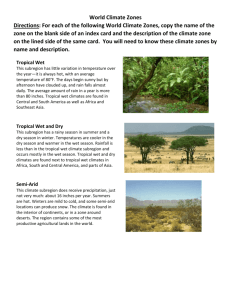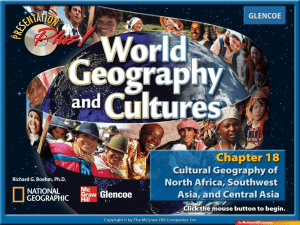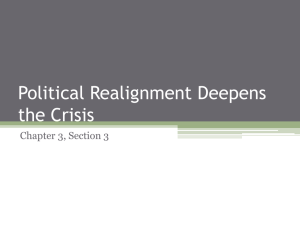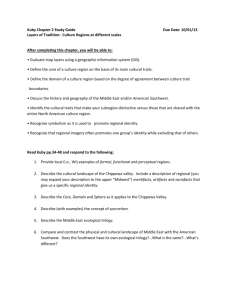Fremont Subregion
advertisement
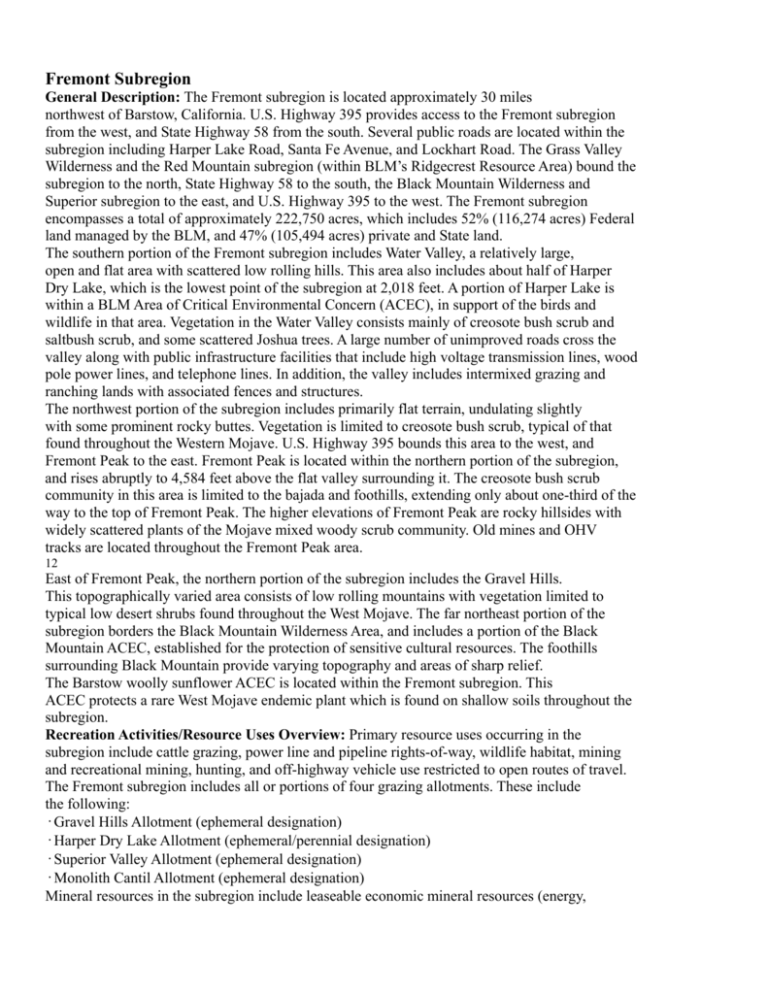
Fremont Subregion General Description: The Fremont subregion is located approximately 30 miles northwest of Barstow, California. U.S. Highway 395 provides access to the Fremont subregion from the west, and State Highway 58 from the south. Several public roads are located within the subregion including Harper Lake Road, Santa Fe Avenue, and Lockhart Road. The Grass Valley Wilderness and the Red Mountain subregion (within BLM’s Ridgecrest Resource Area) bound the subregion to the north, State Highway 58 to the south, the Black Mountain Wilderness and Superior subregion to the east, and U.S. Highway 395 to the west. The Fremont subregion encompasses a total of approximately 222,750 acres, which includes 52% (116,274 acres) Federal land managed by the BLM, and 47% (105,494 acres) private and State land. The southern portion of the Fremont subregion includes Water Valley, a relatively large, open and flat area with scattered low rolling hills. This area also includes about half of Harper Dry Lake, which is the lowest point of the subregion at 2,018 feet. A portion of Harper Lake is within a BLM Area of Critical Environmental Concern (ACEC), in support of the birds and wildlife in that area. Vegetation in the Water Valley consists mainly of creosote bush scrub and saltbush scrub, and some scattered Joshua trees. A large number of unimproved roads cross the valley along with public infrastructure facilities that include high voltage transmission lines, wood pole power lines, and telephone lines. In addition, the valley includes intermixed grazing and ranching lands with associated fences and structures. The northwest portion of the subregion includes primarily flat terrain, undulating slightly with some prominent rocky buttes. Vegetation is limited to creosote bush scrub, typical of that found throughout the Western Mojave. U.S. Highway 395 bounds this area to the west, and Fremont Peak to the east. Fremont Peak is located within the northern portion of the subregion, and rises abruptly to 4,584 feet above the flat valley surrounding it. The creosote bush scrub community in this area is limited to the bajada and foothills, extending only about one-third of the way to the top of Fremont Peak. The higher elevations of Fremont Peak are rocky hillsides with widely scattered plants of the Mojave mixed woody scrub community. Old mines and OHV tracks are located throughout the Fremont Peak area. 12 East of Fremont Peak, the northern portion of the subregion includes the Gravel Hills. This topographically varied area consists of low rolling mountains with vegetation limited to typical low desert shrubs found throughout the West Mojave. The far northeast portion of the subregion borders the Black Mountain Wilderness Area, and includes a portion of the Black Mountain ACEC, established for the protection of sensitive cultural resources. The foothills surrounding Black Mountain provide varying topography and areas of sharp relief. The Barstow woolly sunflower ACEC is located within the Fremont subregion. This ACEC protects a rare West Mojave endemic plant which is found on shallow soils throughout the subregion. Recreation Activities/Resource Uses Overview: Primary resource uses occurring in the subregion include cattle grazing, power line and pipeline rights-of-way, wildlife habitat, mining and recreational mining, hunting, and off-highway vehicle use restricted to open routes of travel. The Fremont subregion includes all or portions of four grazing allotments. These include the following: · Gravel Hills Allotment (ephemeral designation) · Harper Dry Lake Allotment (ephemeral/perennial designation) · Superior Valley Allotment (ephemeral designation) · Monolith Cantil Allotment (ephemeral designation) Mineral resources in the subregion include leaseable economic mineral resources (energy, geothermal, oil and gas), primarily at the southeast portion. Small areas in the northern portion of the subregion have the potential for locatable energy and other strategic mineral resources. Limited areas of known high and very high cultural resource sensitivity occur within the western portion of the subregion. These mostly represent the remains of mining activity and historic travel. The prehistoric remains include a wide range of site types. Areas within the eastern portion of the subregion include known locations of high and very high cultural resource sensitivity/significance, located primarily within the Black Mountain ACEC (established for the protection of prehistoric and Native American resources). The extremely high diversity of site types in this area range from complex to simple, as well as a number of sites listed within a National Register District. Many of the sensitive resources in this area represent historic activities, mostly mining and travel. The prehistoric resources represent habitation, extractive activities, and lakeside adaptations. The suggested vehicle route network provides recreational OHV enthusiasts access to popular OHV areas at Cuddeback Lake and the Fremont Valley, and also maintains a substantial portion of the dual-sport network that runs throughout the subregion. The suggested routes also provide motorized access for rockhounding, recreational mining, equestrian recreation, recreational vehicle touring/sightseeing, and game bird hunting. Superior Subregion General Description: The Superior subregion, located north of Barstow, is bounded by Fort Irwin (National Training Center) and China Lake Naval Weapons Center on the north, the Fremont subregion and Black Mountain Wilderness on the west, and private lands and Interstate-15 on the south. The subregion is 271,528 acres in size, with 192,877 acres (72 percent) of Federal land managed by the BLM, and approximately 77,359 acres (28 percent) either private or State owned land. The major private landowner is the Catellus Development Corporation. The Superior subregion encompasses numerous features that include Mount General, the Waterman Hills, Mud Hills, Fossil Canyon, Owl Canyon, and the Inscription Canyon area, known for its great quantity of rock art. The northern portion of the Superior subregion includes the Superior Valley, an area characterized by low-lying, flat open areas containing two dry lakes: an unnamed, small dry lake at the western edge and the larger Superior Dry Lake at the eastern boundary. The central portion of the subregion includes the Black Mountain Lava Flows, Lane Mountain, and the Paradise Range. The Rainbow Basin, located in the south-central portion of the subregion, is an ACEC and is not included in the Superior subregion. Access to areas within the Rainbow Basin (which include the Mud Hills, Fossil Canyon, Owl Canyon campground, and the Rainbow Basin National Natural Landmark) is obtained via the Superior subregion. The southern portion of the subregion encompasses Mud-Water Valley, Waterman Hills, and outlying areas of Barstow. Elevations range from approximately 2000 feet in the southeast to 4,522 feet at the peak of Lane Mountain in the central-eastern portion of the subregion. Vegetation in the northern portion of the subregion is similar to other areas in the West Mojave. In the Lane Mountain area, vegetation consists of creosote/mixed desert scrub association with scattered Joshua Trees and golden cholla. The Paradise Range in the northeast include a series of volcanic, rocky hills that exhibit little vegetation on the slopes, with the exception of scattered creosote. Vegetation is similarly sparse within the Black Mountain Lava Flows at the central portion of the subregion. The vegetative cover in the southern portion of the subregion generally is sparse, and includes occasional Joshua Trees. The Superior subregion is criss-crossed by a number of roads, mainly unimproved. Access 28 from population centers to the Superior Valley in the north is provided via Copper City Road, an improved road via Fort Irwin Road, and a paved highway. Due to these access routes, the Superior Valley is easily reached, as demonstrated by the noticeable presence of recreational visitors in this portion of the subregion. Access to the subregion from the south is obtained from Interstate 15, State Route 58, and Irwin Road. Recreation Activities/Resource Uses Overview: Primary recreation activities and other resource uses occurring in the subregion are rockhounding, camping, picnicking, powerline and pipeline rights-of-way, mining and recreational mining, hunting, and off-highway vehicle use. Excellent opportunities for both hiking and backpacking exist in the Black Mountains, Opal Mountains, and Calico Mountains. Major activities include camping, rockhounding, hunting, and motorcycle free play. The hard, smooth surfaces of two dry lakes in the Superior Valley provide excellent conditions for land sailing. The OHV community also utilizes this portion of the subregion, although the flat terrain is less than ideal for their activities. The suggested vehicle route network provides the recreational OHV enthusiast an expansive variety of opportunities from which to choose. Routes vary from long, flat graded utility corridor routes or the flats of Superior Valley; technical jeep routes in the Calico Mountains; technical single-track motorcycle routes in the Mud Hills; lengthy remote touring routes around the Black Mountain wilderness or through the Grass Valley wilderness corridor; short quickly accessible routes into the Mitchell Range or Waterman Hills; and those that provide a loop opportunity to those that are "dead-ends". Additionally, the suggested route network provides access to a variety of destinations ranging from historic mining sites (e.g. Calico Mountains), prehistoric cultural zones (e.g. Inscription Canyon), upland springs (e.g. Sweet Water Spring), geologically unusual areas (e.g. Rainbow Basin), rock-hounding areas (e.g. Opal Mountain), recreational mining (e.g. Coolgardie area); and mountain bike recreation throughout the subregion. Public lands within the California Desert District of the Bureau of Land Management fall within one of the following three types of vehicle use designations: • • • (1) Areas that are CLOSED to all vehicle travel, such as designated wilderness and Areas of Critical Environmental Concern. (2) In the Open Areas of Stoddard Valley, Johnson Valley, El Mirage, Dumont Dunes, and Rasor cross-country travel is designated OPEN and is allowed. (3) The remainder of the BLM-managed lands are LIMITED areas on which vehicles can travel only on existing or designated routes. Primitive Camping Except for "special areas" with specific camping regulations, visitors are welcome to camp anywhere on BLM managed land. Please follow these common sense rules: • • • • • If you camp in a vehicle, you can camp off of any posted Open Route, (but no more than 300 feet) as long as your group does not block traffic on the road or trail. Obey vehicle restrictions for the area. This is primitive camping, so do not trench or otherwise modify the ground or remove vegetation to "improve" the camp site. When possible, use an area that has been used for camping before. Avoid building new fire rings. If there is one near your site, please use it. From May through October, there are seasonal fire restrictions requiring fires to be kept small in enclosed structures like barbeques or fire rings and have at least a 15 foot clearance around the fire. A fire permit is required during these times and can be obtained at any BLM office or state fire station. Keep in mind that during extremely hot and dry conditions, second stage fire restrictions may come into effect, allowing no open fires. Pack out your trash. As more people come up to enjoy desert camping, it becomes even more important to keep a clean camp and leave your camp site better than you found it! There is a 14 day limit for camping in any one location. Enjoy your camp site, then move on to allow others to enjoy it! This rule is modified at the El Centro Field Office, where there are a number of Long-Term Visitor Areas.
